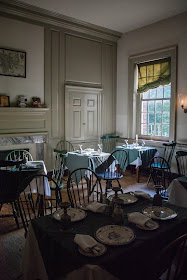Elfreth's Alley was one of the things I was most looking forward to seeing, I had envisioned the quaintest little street, lined with small colorful homes and lots of red brick everywhere, I was not disappointed!
Elfreth’s Alley is the nation’s oldest continuously inhabited residential street. Named for blacksmith and property owner Jeremiah Elfreth, Elfreth’s Alley was home to the eighteenth-century artisans and tradespeople who were the backbone of Colonial Philadelphia.
Over 300 years later, the historic 32 houses that line the street remain hot properties, and this itty-bitty cobblestone alley is a designated National Historic Landmark.
I'm not sure if one of the rules of living on this historic street is to have and upkeep beautiful window boxes, but it sure looked like it might be, all the houses and gardens were so beautiful manicured.
On our "wear red, white or blue" days, all the boys in the group always chose blue haha so it was up to me, mom and Karin to incorporated the red and white.
After our stroll down history's memory lane, we headed over to Christ Church. Dating to 1744, the current building has been cited as “our finest Early American church” and one of the finest Georgian structures in America. Its steeple (1754), financed by a lottery organized by Benjamin Franklin, is the work of Robert Smith, one of America’s earliest architects. For 56 years, the steeple made Christ Church the tallest structure in North America.
Christ Church, the birthplace of the American Episcopal Church, was founded in 1695 as a condition of William Penn’s Charter. Known as “The Nation’s Church,” it hosted members of the Continental Congress during the American Revolution and Presidents George Washington and John Adams in the first decade of the newly established Republic. Among early members were Benjamin and Deborah Franklin, Betsy Ross, John Penn (William Penn’s grandson), and signers of the Constitution and of the Declaration of Independence, including Robert Morris, Benjamin Rush, and Francis Hopkinson.
Christ Church's Bells are one of three rings of bells which were installed in the United States prior to the American Revolution. The Bells were cast by the foundry at Whitechapel, England owned by Thomas Lester and Thomas Pack, the same firm which first cast the Liberty Bell two years before Christ Church's bells were cast in 1754. The bells of the Old North Church in Boston (1744) complete the set.
Then we walked over to the Museum of the American Revolution, which is a museum dedicated to telling the story of the American Revolution. The museum opened to the public on April 19, 2017, the anniversary of the first battle of the war, Lexington and Concord, on April 19, 1775. The museum owns a collection of several thousand objects including artwork and sculpture, textiles and weapons, manuscripts and rare books. Permanent and special exhibition galleries, theaters and large-scale tableaux portray the original "greatest generation," and engage guests in the history and continuing relevance of the American Revolution.
The Burton boys demonstrating how soldiers slept in their tents, each tent could fit 5 soldiers.
Karin, Thomas and I had fun at this interactive activity called Smelladelphia. Each container had a smell that would have been present in the town during the revolutionary war. We each took a smell, made our guesses of what we thought it was, then the staff member would give us the answer, Thomas wrote down all the answers for us.
Upstairs, there is a theater that shows a movie about George Washington's war tent. At the end of the movie, the screen slowly glides up to the ceiling, revealing the actual, preserved tent.
Washingtons tent was used as the war's headquarters, the tent was their workplace, where they managed the commander-in-chief's correspondence and made copies of his orders. A divided section of the tent was where Washington slept.
These amazing panels are on the side of the museum, we passed by them on our way to dinner.
For dinner that night we ate at the historic City Tavern, an establishment that was frequented by several of the founding fathers and it was the venue for several high profile events such as the first anniversary celebration of the 4th of July. The original building burned down, but the building is a replica and still stands on the same ground as the original building.
There is a timeline of the tavern's history in the menu.
They serve typical 18th century food and drink at the Tavern, we were all very curious about the colonial raspberry shrub, so a few of us ordered it. It basically tastes like a berry lemonade.
While reading the menu, I was fascinated to discover that Benjamin Franklin knew how to make tofu back in the day. Of course it was Franklin that knew about tofu, that makes sense, he knew about everything.
After dinner, we walked back to our hotel. We got to see several of the historic buildings all lit up at night. We also chased fireflies, being from the west, fireflies are a rare and magical sight for us.































































